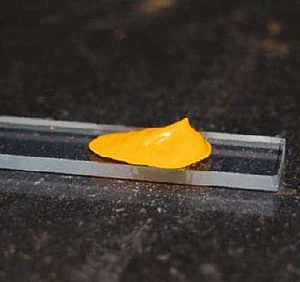Researchers have successfully managed to create a “solar paint” made out of quantum dots, which exhibits similar properties to multifilm solar cell architectures. The later are sophisticated, expensive and require a lot of time to deploy; the paint can be easily applied to basically any surface, like a house’s roof, and prepare it to easily generate photocurrent.

Quantum dots, simply put, are crystal semi-conductors that display unique optical and electrical properties that are different in character to those of the corresponding bulk material – its discrete properties translates into quantum behavior. These tiny crystals, which range from 2 to 10 nanometers in diameter, were added to dye mixtures. The researchers used three separate quantum dots dyes, based on CdS, CdSe, and TiO2, respectively. The later is used to make most of today’s commercial dyes, however instead of painting a fence in a certain color, the quantum dots based paint will allow it to exhibit optical and electrical properties.
“Quantum dots are semiconductor nanocrystals which exhibit size-dependent optical and electronic properties,” said Prashant V. Kamat of the Radiation Laboratory and Department of Chemistry and Biochemistry at the University of Notre Dame in Indiana, one of the lead authors of the study. “In a quantum dot sensitized solar cell, the excitation of semiconductor quantum dot or semiconductor nanocrystal is followed by electron injection into TiO2 nanoparticles. These electrons are then transferred to the collecting electrode surface to generate photocurrent. The holes that remain in the semiconductor quantum dot are removed by a hole conductor or redox couple and are transported to a counter electrode.”
Quantum dots have been used in transistors, lasers, LEDs or solar cells. Solar cells made with quantum dots require a number of time intensive steps for layering the tiny crystals, and is typically considered an expensive technology. In contrast, the paint, researchers say, can be applied and dried like any other conventional paint. Of course, its efficiency is quite low – only 1%, compared to at least 5% in the case of multi-layered quantum dot solar cells.
On a related note, researchers from the US Department of Energy’s National Renewable Energy Laboratory (NREL) have for the first time built a solar cell, based on quantum dots, with an external quantum efficiency of over 100 percent.
“If we can optimize the paint preparation, it should be possible for anyone to open a bottle (or a can in the long run) and apply it to a conducting surface,” he said. “This will decrease the variability between lab to lab or person to person as one encounters in a multi-step process. Having fewer fabrication steps and ambient preparative conditions should provide an economically viable transformative technology.”
Scientists are now working on the next critical step, improving efficiency (they hope to do this by using other semiconductor materials for higher absorption range) and the other two components of a solar cell array; a hole conducting layer and a counter electrode network.
I think this kind of technology is amazing, although its performances aren’t competitive enough yet, however the researchers hoping to make it commercially available in the near future. Perfect for DIY projects or large-scale, cheap solar energy programs; whole neighborhoods filled with solar paint.
“The goal is to prepare a solar paint that has long shelf life,” Kamat said. “In our laboratories we have tested the performance for a few days to a week, and we find it stable as long as it is stored in the dark. Additional tests are underway to investigate long-term stability of paints with different compositions.”
This post has been brought to you by Opus Energy.


